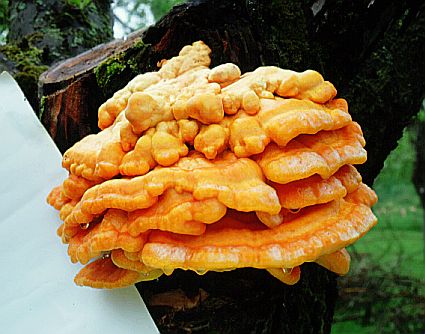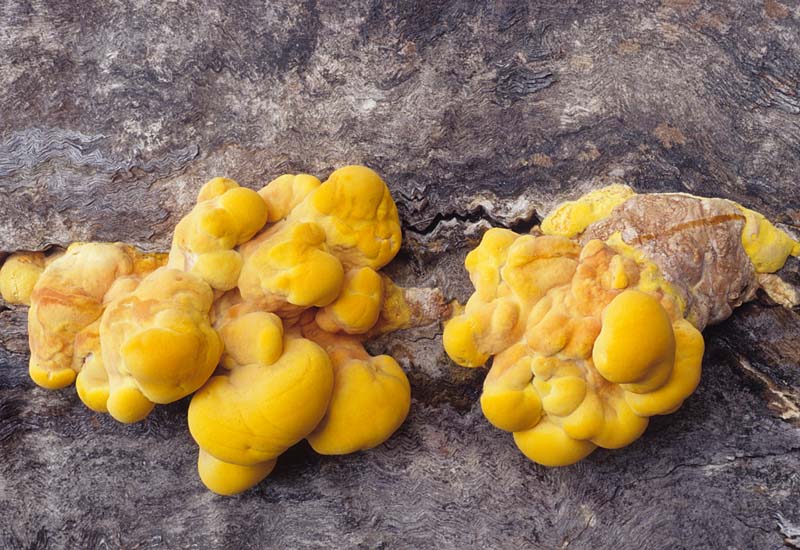Elite life |
 |
|
Mushrooms |
Laetiporus |
|
Laetiporus is a genus of edible polypores growing throughout much of the
world. Also known as the sulfur shelf, chicken of the woods, the chicken
mushroom, and the chicken fungus. It is, as one might expect, an edible
mushroom with a taste quite similar to lemony chicken. The mushroom
grows in large brackets - some have been found that weigh over 100
pounds (45 kg). It is most commonly found on wounds of trees, mostly
oak, though it is also frequently found on yew, cherry wood, sweet
chestnut and willow. |
|
║ Mushrooms ║ |
Chicken of the Woods (Laetiporus sulphureus) |
 |
|
|
|
The
"Chicken of the Woods" is a popular edible, and easily recognized by its
color, soft texture, and absence of gills. Though the Chicken of the
Woods is a safe and easily recognized edible mushroom, it should not be
eaten raw; there are reports of people being adversely affected when the
mushroom was not cooked. Growing alone or, more typically, in large
clusters on decaying logs and stumps of hardwoods and conifers; summer
and fall, rarely in winter and spring; widely distributed as a species
cluster. Distribution: America and Europe. Season late spring to autumn,
annual. |
Description:
Bracket
10-40 cm across, fan-shaped or irregularly semicircular, thick
and fleshy, usually in large tiered groups; upper surface uneven, lumpy,
and wrinkled, suede-like, lemon-yellow or yellow-orange drying pallid or
straw-coloured; margin obtuse. Flesh at first succulent and exuding a
yellowish juice when squeezed, but white and crumbly with age. Taste
pleasant and slightly sourish, smell strong and fungusy. Tubes 1.5-3mm
long, sulphur-yellow. Pores 1-3 per mm, circular or ovoid, sulphur-yellow.
Spores white, ellipsoid to broadly ovate, 5-7 x 3.5-4.5 μm. Hyphal
structure dimitic with generative and binding hyphae; generative hyphae
without clamp-connections. Habitat deciduous trees, usually oak but
common also on yew, cherry, sweet chestnut and willow. |
Sulphur Shelf, Chicken of the Woods (Laetiporus gilbertsonii) |
 |
|
Habitat: Late summer to early fall on logs and stumps of hardwoods. It
is particularly common on species of Eucalyptus. Edible with
caution. Prized by many, this species is also known to cause
gastrointestinal upsets. Controversy exists whether the upsets are
caused by old specimens, improperly cooked specimens, specimens growing
on certain trees (Eucalyptus has be mentioned as a suspect host),
or some other cause. If you decide to try it, eat only the young, fresh,
growing margins, in small quantities, and cook it thoroughly. |
Description:
Sporocarp: Fruiting body annual; sessile to substipitate, consisting of
overlapping, rounded fleshy shelves, 7-55 cm broad, upper surface smooth
to roughened, yellow with reddish-orange to orange bands, margin yellow,
irregular; flesh 2-3 cm thick, white to yellow; lower surface finely
pored, bright yellow; in age fruiting body becoming dry, white and
crumbly.
Spores 5-7 x 4.0-5.0 μm, oval, smooth. Spore print white. |
White-Pored Chicken of the Woods (Laetiporus cincinnatus) |
 |
|
Laetiporus cincinnatus has a white, rather than yellow, pore surface.
Like Laetiporus sulphureus, it prefers hardwoods, especially oak, and is
found east of the Rocky Mountains. Laetiporus cincinnatus fruits from
the roots of trees (thus often appearing terrestrial), which helps to
separate it from Laetiporus sulphureus, which typically fruits on logs
or well above the ground on stumps and trees. Growing from the roots of
hardwoods (nearly exclusively oak) near the bases of trees, thus
sometimes appearing terrestrial; in clusters of rosettes; summer and
fall, rarely in winter and spring; east of the Rocky Mountains. |
Description:
Fruiting Body: 5-60 cm broad, up to 4 cm thick; fan-shaped to obtusely
semicircular; smooth to wrinkled; suedelike; bright to pale orange,
often with vague concentric bands of alternating shades of color;
frequently fading in maturity and with direct sunlight.
Pore Surface: Tightly packed and nearly invisible when young; white.
Flesh: Thick; soft and watery when young, becoming tough, eventually
crumbling away; white.
Spore Print: White. Spores 5-7 x 3.5-5 μm; smooth; broadly elliptical
to round. |
|
|
|
║ Mushrooms ║ |


